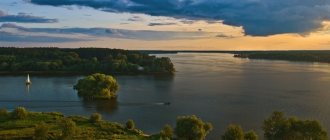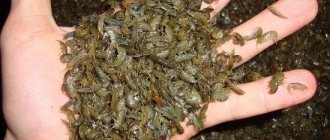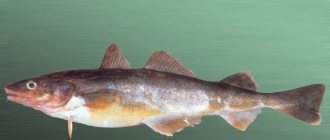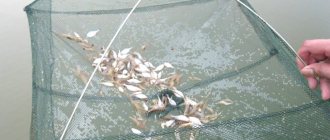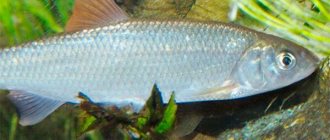- Wild animals
- >>
- Fish
Smelt is a small fish that comes in freshwater and saltwater. Its numbers in its habitats are very high. Smelt is constantly caught for commercial purposes, but despite this, its numbers remain stable. This small fish is also very popular among amateur fishermen; there are many of it in cold seas.
All varieties of the smelt family are, in principle, similar. But the Far Eastern smelt, unlike the others, has a smaller mouth with a lower jaw pushed forward, and its dorsal fin is shorter than that of other representatives of this family. In the Far East and Sakhalin, ice smelt is very popular among winter fishing enthusiasts; it is also called “voroshenka”. She is caught in an ice hole, and she freezes right there in the cold. Freshly caught smelt is characterized by the smell of cucumbers, so smelt also has another name - borage.
Smelt lives in large schools in the seas (in those places where the bottom is sandy) or lakes. When the spawning period begins, it migrates to the mouths of rivers - where there is no fast current.
Origin of the species and description
Photo: Smelt
There is confusion regarding the classification of smelt. You can often find disputes about whether this small fish belongs to the herring or salmoniformes. We can say with confidence that both are right. The confusion arises because those arguing have different classification groups in mind. As is known, when defining a particular species, they usually go from a larger taxon (group in the classification) to a lower one: superorder - order - family - genus - species or subspecies. We will focus on two classifications.
In the atlas-identifier of fish N.A. Myagkova (M. “Prosveshcheniye”, 1994) proposed the following classification. The author of the atlas identifies a superorder of clupeoids, which includes the order of herrings and the order of salmonids. The smelt family belongs to the order Salmonidae. The following is a classification by type.
European smelt. She, like all smelts, has teeth on her jaws. The line on the side is visible only up to 4 - 16 scales. The barrels are silver, the back is brown-green. The length of this species of smelt is about 20 centimeters.
Smelt. A small freshwater fish with weaker teeth than the European fish. Its body length is about 6 centimeters, sometimes a little more.
Toothed smelt. She has powerful teeth compared to other species. The line on the side is visible up to 14 - 30 scales. It reaches 35 centimeters in length. This is an anadromous and lake fish.
River smallmouth smelt. The fish of this species resembles sprat in appearance. A silver stripe is clearly visible along her entire body. Black dots can be seen on the scales and fins. Its size is about 10 centimeters.
Smallmouth smelt. This species, unlike the river smallmouth, does not have silver stripes and black dots. If there are black dots, they are difficult to distinguish. Smallmouth sea smelt is slightly larger than river smelt - its length is about 12 centimeters.
Capelin. This is a sea fish, the fattest of all types of smelt. She has silver barrels, against which the lateral line is clearly visible, which runs throughout her body, right down to the anal fin. The back of capelin is blue-green. The average length of capelin is about 20 centimeters.
In the book “Fishes of the USSR” by the authors V. Lebedeva, V. Spanovskaya, K. Savvitov, L. Sokolov and E. Tsepkin (M., “Mysl”, 1969) the order of herrings is also highlighted, in which, in addition to the salmon family, there are smelt family.
The following is a classification by genus and species:
- genus of smelt. Species – European and Asian smelt “catfish”;
- genus smallmouth smelt. Species – smallmouth smelt, or borage;
- capelin genus. Type – capelin, or uyok;
- genus golden smelt. Species: golden smelt or silver smelt.
Appearance and features
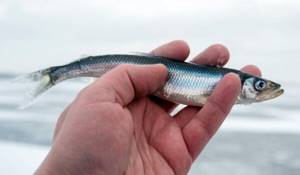
Photo: Smelt fish
Smelt is a fish that lives in numerous schools. Its appearance depends on what species it belongs to. The strength and sharpness of the teeth located on the jaws also depends on what species this small predator belongs to. The body length of smelt, depending on the species, ranges from 6 to 35 cm. The body shape is spindle-shaped, elongated; The mouth is large in proportion to the length of the fish itself. All varieties of smelt look similar: the body has a silvery tint, the back is darker than the barrels and belly and has a greenish-brown tint, the fins are either grayish or almost transparent.
But the Far Eastern smelt (also known as borage or naked), unlike the others, has a proportionally small mouth. Its scales are also small and completely transparent. The belly of the Far Eastern smelt is not silver, but white-yellow, and on the back the scales are greenish-bluish. European smelt (or smelt) has dense, relatively large scales for its size and a green-brown back. Her body configuration is narrower and elongated compared to the others.
The smelt, which lives in lakes, has colorless fins and a light back, and this allows it to camouflage itself in a lake with a muddy bottom. A characteristic difference between fish of the order Salmonidae is two dorsal fins, one of which is real, and the second, smaller one, is adipose. This is a rounded fin that does not have real fin rays and is located in the caudal region. By this feature, salmon can be easily distinguished, for example, from herring. Representatives of the smelt family, which, as mentioned above, belong to the order Salmonidae, have an adipose fin.
Useful and harmful properties of smelt
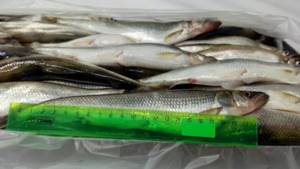
This type of fish contains a lot of useful substances for the body; it is rich in healthy protein, fats, and is especially high in sodium. This element is necessary for the cardiovascular system and providing cells with glucose. The entire supply of nutrients is easily and quickly absorbed by the body.
Smelt is almost always eaten with the bones, which is also good for joints and bones and prevents osteoporosis. The high content of vitamin A helps improve vision, as well as obtain the necessary and important collagen.
It is very useful to eat fish in order to prevent many diseases; it improves metabolic processes, so it can be an ideal food for those who want to lose weight. Fish is always popular and affordable for many people. It must be said that fish can also cause harm to the body if there is one that lives in polluted waters. In such a habitat, smelt accumulates heavy metals and harmful substances, so it is better not to eat fish caught in contaminated water.
Video
Where does the smelt live?
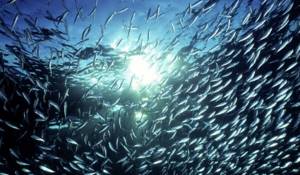
Photo: What smelt looks like
The distribution areas of fish from the smelt family are extensive. It should be noted that smelt has a good ability to acclimatize.
Asian smelt is common in the White, Baltic, and Northern seas. There is a lot of it in the Far East, in particular on Sakhalin, Chukotka, and the Kuril Islands. Fish choose coastal waters as their place of residence. Asian smelt also lives in Siberian and Far Eastern rivers.
European smelt lives in the Baltic and North Seas. In addition to the seas, she also lives in lakes - for example, in Ladoga and Onega. Due to its good acclimatization, the fish spread in the Volga River basin.
Freshwater smelt lives in many lakes in the European part of Russia, as well as in lakes in Western Europe. You can also find it in the north-west of Russia. The fish, as a rule, prefers sandy places and avoids strong currents.
The smallmouth nakedfish lives off the sea shores of the Far East, but being an anadromous fish, it also enters rivers. There is a lot of it on Sakhalin, off the southern coast of the Kuril Islands, in Kamchatka, right up to the coast of the northern part of Korea.
Using good acclimatization of smelt, it was released into lakes in the north-west of Russia and into the Ural lakes. Sometimes this fish itself chooses new places of residence. It appeared in some reservoirs - for example, Rybinsk, Gorky and Kuibyshevsky.
What does smelt eat?
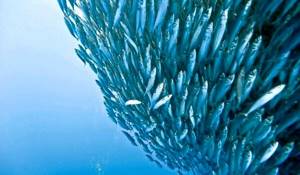
Photo: Far Eastern smelt
Fish belonging to the smelt family feed actively, regardless of the time of year. But smelt is especially voracious in summer and autumn. Because these small fish have sharp teeth on their jaws, smelts are considered predators. The smelt's mouth is naturally small, but its teeth are numerous.
Small predators often prefer depth, not only to hide from other predators, but also to find food for themselves: to catch fry, smaller fish than the smelt itself. Smelt also feeds on eggs laid by other fish, planktonic algae, dipteran insects and their larvae, and crustaceans. By the way, the gluttony of this fish means that fishermen who love smelt, as a rule, are not left without a good catch. Depending on their size and the structure of the oral cavity, different types of smelt have their own food preferences.
Due to its size, which is different from larger individuals, a small naked has, accordingly, a small mouth. The teeth on the jaws of this fish are small and weak. Therefore, smallmouth smelt catches fry and eats crustaceans, larvae, and caviar. And due to the fact that the small mouth is directed upward, it also feeds on flying dipterous insects.
Since European and Asian smelt are the largest of the smelt family, they have a large mouth and strong teeth. These fish have their own feeding habits. They feed on bottom crustaceans, plankton, chironomid larvae (representatives of the order Diptera), and small fish. It happens that in the stomach of a smelt one finds its brothers - smaller smelts. This is explained by the fact that “tribesmen” eat each other in those bodies of water where there is no other food.
Nutrition
Despite their small size, all types of smelt are voracious. The bulk of the daily diet consists of zooplankton. However, this small fish is not averse to feasting on fry, which is not much smaller than it. Smelts love various small animal organisms. Numerous swarms destroy fish eggs, insect larvae, as well as amphipods, daphnia and cyclops. Since smelt is not too picky about its diet, and also acclimatizes quite easily to new conditions, it began to be artificially bred in industrial quantities. This requires a deep pond with cold running water. Lakes located in the central part of Russia are best suited for fish farming.
Features of the smelt lifestyle

Photo: Smelt
Smelt is a fish that lives in large schools. This helps her not only migrate during spawning, but also escape from enemies. This fish is intolerant of water pollution and, accordingly, prefers clean water bodies for its residence. Therefore, in many heavily polluted rivers, the number of smelt, which was once a commercial fish there too, has decreased significantly. Representatives of the smelt family love depth, so they prefer deep places in lakes, rivers or seas. In addition, by varying the depth, the fish tries to hide from other predators.
Unlike the vast majority of fish, the spawning season for smelt is spring. Speaking about spawning, it is worth noting that depending on the place of their residence and the presence or absence of migration, fish are anadromous and residential. Migrants live in the seas, but rise into rivers to spawn. That is, these are fish that make spawning migrations from seas to rivers. Residential fish are those fish whose life cycle is not connected with the sea; they constantly live in rivers or lakes.
Selection and preparation of gear
It is no secret that both river and sea smelt are considered very popular fishing prey, which can be caught almost all year round. Here you need to take into account the regional characteristics where fishing takes place.
For example, St. Petersburg smelt bites well in December, however, during this period only small representatives of the species are caught on the hook. To catch six kilograms of fish, you need to get at least five hundred units from the hole. If the priority is to search for trophy prey, then it is better to wait until the end of January or the beginning of February. The main advantage of such an activity is its excitement and extremeness. In order not to leave the reservoir without a catch, it is important to show skill and endurance. Otherwise, instead of a good bite, the fisherman may face complete disappointment.
As for the suitable gear for catching such fish, unlike capelin, there is no need to use too expensive or inventive fishing tools, because the weight of the prey is relatively small, so even the lightest fishing rod can easily cope with the load.
The next selection criterion is the convenience of the gear. The devices used should not take a lot of energy from the angler during the fishing process. In addition, fishing in the winter season requires some skill and diligence, so operating comfort becomes a paramount factor. When fishing with comfortable gear, there is no risk of fatigue and lack of pleasure from the process.
Reproduction of smelt
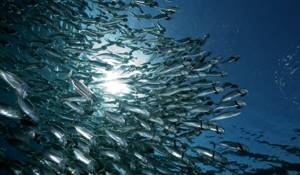
Photo: Smelt fish
Smelt reproduces by eggs. That is, in its life cycle there is a spawning period. Since the life expectancy of fish of this family is different, sexual maturity also occurs at different ages. For example, if smelt lives up to 3 years, then it becomes capable of reproduction at 1-2 years. Asian smelt and Siberian smelt, which have a lifespan of 10 or 12 years, become adults at the age of 5-7 years. For example, migratory smallmouth smelt mature at 2 or 3 years and then migrate to rivers in the spring to spawn. In its entire life, such smelt spawns no more than 3 times.
The fish often travels great distances for its size on its way to streams and rivers to lay eggs. This path is sometimes tens of kilometers long. The spawning process itself lasts for several days. Fish choose a place to lay their eggs so that there is a lot of food for future fry, as well as few predators. During spawning, the appearance of the fish changes slightly - males have tubercles on their scales, females too, but they only have them on their heads.
Smelt spawning begins at different times depending on the region. It depends on the water temperature. It usually occurs shortly after the ice melts. The water temperature should be favorable at this time - not lower than +4 degrees. But the peak of spawning occurs at a time when the water temperature becomes slightly higher (6 - 9 degrees). Fish spawn in the spring, usually in late April or early May. To lay eggs, smelt chooses shallow places with running water.
Smelts lay eggs directly on the bottom. It should be sandy, rocky or sandy-muddy. The female lays about four thousand eggs. The eggs have a sticky shell. Thanks to this, they stick to stones and underwater plants or to some objects on the bottom. In addition to the outer adhesive shell, the eggs also have an inner shell, similar to that found in all fish. When the egg swells, the outer shell bursts, releases the inner one and turns inside out. But it remains connected at one point to the inner shell. It looks like a kind of stalk on which the egg with the embryo swings freely in the water.
Dead eggs gradually come off, they are carried away by the current, and the outer shell acts as a parachute and facilitates their movement in the water. Thanks to this, the spawning grounds of smelt are freed from unnecessary eggs, and future young animals develop in more favorable conditions. At the moment the shell ruptures, the fertilized egg breaks away from the bottom. The eggs floating with the flow continue their development, and 11–16 days after the females have swept them out, thin larvae emerge from them. Their length is approximately 12 millimeters. Soon these larvae, continuing their path downstream, begin to catch food: plankton, small crustaceans.
Spawning
Before the mating season, most sexually mature representatives of smelt go through a different migratory route. Its length depends on its habitat. If species living in the White Sea spawn in nearby streams, then the Yenisei relatives can travel about 1 thousand kilometers. The flocks spend approximately 3-4 months on this move. Amur individuals go to spawning grounds, which are located within 300 km. And coastal smelts enter rivers no further than 20 km. Lake inhabitants prefer to lay eggs at the mouths of inflowing rivers. As soon as the water warms up to 4ºC, the first individuals begin to spawn. The most massive smelt spawning occurs after the water temperature reaches 7-10ºС. Accordingly, the timing of the marriage period differs significantly. In the waters of Western Russia, the beginning of spawning dates back to March, while in the east of the country spawning occurs from April to May, and in Siberia the mating season is observed only in the summer. The duration of spawning is limited to 2-3 days, after which the fish leaves the spawning ground. The masonry is located at a depth of up to 2 m, where there are stones, tree roots or abundant vegetation. The eggs hatch into fry after 15-20 days. They immediately go downstream, feeding on plankton. As they mature, they switch to worms, eggs and fish fry.
Natural enemies of smelt
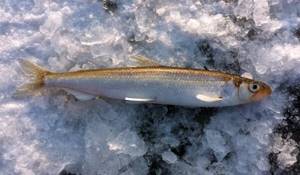
Photo: What smelt looks like
This fish faces many dangers throughout its life. It feeds on fish that are significantly larger than it.
And there are more than enough of these in the expanses of water:
- salmon;
- pike;
- cod;
- burbot;
- zander;
- brown trout;
- palia;
- perch;
- Baltic herring
The smelt has, although not very reliable, a method of defense available to it from predators larger than itself. Adult smelt usually form schools. A densely populated flock behaves harmoniously and unitedly. When danger arises, fish in a school closely approach each other and form, as it were, a single whole. All individuals in the school begin to swim synchronously, while they simultaneously change the direction of movement.
Smelt eggs and larvae are also food for many fish. Especially when you consider that fish of this family spawn in the still hungry early spring. And since there is still little food for the fish that are hungry over the winter in the spring, they eat large quantities of smelt larvae and fry. Not only underwater inhabitants, but also birds are also natural enemies of smelt. During the spawning period, smelt often rises to the surface, and birds snatch it right out of the water.

